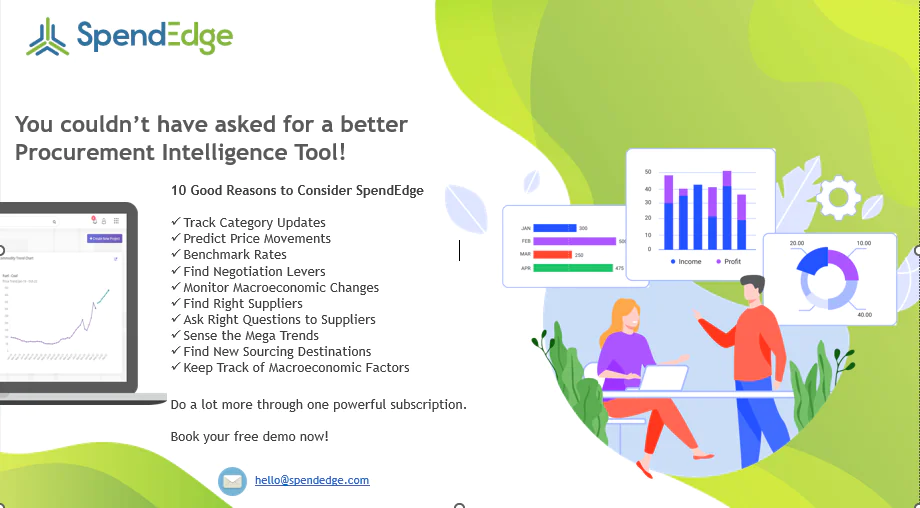Cost analysis is no longer just a tool—it’s a strategic imperative that empowers businesses to navigate the complexities of supply chains, optimize procurement strategies, and unlock significant cost-saving opportunities. With the rise of advanced technologies like AI, predictive modeling, and blockchain, traditional costing methods are being transformed into powerful frameworks that deliver deeper insights and foster stronger supplier relationships.
Should Cost Analysis, a game-changing approach pioneered by the U.S. Department of Defense, has evolved into a dynamic tool for industries ranging from manufacturing and automotive to retail and CPG. By breaking down the true cost of products—factoring in materials, production, and lifecycle costs—it enables procurement leaders to make informed decisions, enhance supplier collaboration, and stay resilient against market volatility. This blog explores the transformative role of Should Cost Analysis, upcoming trends in cost analysis, and how SpendEdge’s advanced solutions empower businesses to stay competitive and maximize profitability.
What is a should cost analysis?
Should Cost Analysis is a powerful cost-estimating tool that helps businesses determine the ideal price of a product by analyzing input materials, production costs, and profit margins. It enables supply chain professionals to negotiate fair prices, strategically source components, and make informed decisions based on market intelligence. Originally developed by the U.S. Department of Defense, this methodology has become essential across industries like manufacturing, automotive, and CPG. By using Should Cost Analysis, organizations can optimize procurement, strengthen supplier relationships, and enhance profitability, although its complexity often discourages some from fully leveraging its benefits.
The True Value of Should Cost: A Strategic Benchmark for Cost Engineers
For manufacturers, leveraging a should cost model, combined with comprehensive manufacturing process data, provides several key advantages:
- Enables more strategic sourcing of components.
- Grounds supplier negotiations in reliable, data-driven insights and deep manufacturing expertise.
- Allows for accurate procurement cost estimation and modeling for new designs, eliminating the need for supplier quotes to proceed.
Connect with us today to explore how SpendEdge’s advanced Should Cost Analysis can help you achieve strategic procurement excellence and maximize profitability…
Should Cost vs. Will Cost: Understanding the Key Differences for Effective Cost Management
| Aspect | Should Cost | Will Cost |
|---|---|---|
| Definition | Should Cost is an estimation of what a product or service should cost based on factors like raw materials, labor, and overheads. | Will Cost represents the actual price a company pays for a product or service, including supplier quotes, contracts, and negotiations. |
| Purpose | Used as a benchmarking tool to evaluate whether the proposed price is fair and aligns with industry standards. | Reflects the actual cost incurred by the business, often resulting from supplier negotiations or market conditions. |
| Data Sources | Relies on market intelligence, historical data, and cost models to predict potential cost elements. | Based on current contracts, invoices, and agreed pricing with suppliers. |
| Use Case | Helps identify cost-saving opportunities, optimize procurement strategies, and negotiate better prices. | Used for budget planning, actual cost tracking, and ensuring profitability by evaluating current financial outcomes. |
| Impact on Decision-Making | Empowers procurement professionals to make data-driven decisions, set realistic budgets, and negotiate effectively with suppliers. | Provides clarity on whether actual expenses align with budgets, offering insights for financial adjustments and cost management. |
| Strategic Advantage | Offers a proactive approach to cost management by forecasting and planning for potential price fluctuations. | Gives a reactive snapshot of the business’s financial position, enabling real-time cost tracking and adjustments. |
| Time Horizon | Future-focused—helps forecast costs for new projects or products. | Present-focused—reflects the actual costs at the time of purchase. |
Key Steps in Should Cost Analysis: A Strategic Approach to Cost Optimization
-
Begin by breaking down the product into its core components, considering every material, part, and labor cost involved. This step provides a comprehensive view of the product's structure, laying the foundation for accurate cost estimation.
-
Separate direct costs (e.g., raw materials, labor) from indirect costs (e.g., overhead, logistics). This helps in understanding how each element contributes to the overall cost and enables targeted cost reduction strategies.
-
Gather pricing data from suppliers, including historical pricing, market trends, and supplier quotes. This data serves as a benchmark for estimating a fair price and guides negotiations to ensure competitiveness and value for money.
-
Use predictive modeling to forecast potential cost fluctuations based on various scenarios, such as material price changes or shifts in labor costs. This proactive approach allows businesses to stay ahead of cost challenges and adjust procurement strategies accordingly.
-
Incorporate profit margin targets to ensure the product’s final cost aligns with business objectives. By understanding the balance between cost reduction and profitability, businesses can make strategic decisions that enhance long-term growth.
-
Foster open communication with suppliers to ensure cost transparency. Sharing should cost data can lead to improved collaboration, better terms, and innovation-driven partnerships that benefit both parties.
-
Continuously update should cost models to reflect changes in market conditions, supplier dynamics, and production processes. Regular reviews ensure that cost strategies remain relevant and competitive in a constantly evolving marketplace.
What do organizations follow to determine the product cost?
Business entities have termed the new age should cost analysis as something beyond their understanding. This is because they are accustomed to traditional product costing methods such as cost structure analysis, activity-based costing, and strategic sourcing. There is no doubt that these are effective cost analysis methods but there’s a flip side to it. These cost methods are often one-dimensional, rigid, costly, and difficult to scale across functions or cost elements, and they do not help in building a strong supplier relationship. As a result, the organizations fail to take into consideration the 360-degree view of the supply market, competitive landscape, and trends in the industry.
The Key Benefits of Should Cost Analysis for Strategic Procurement and Cost Optimization
Should Cost Analysis (SCA) provides organizations with a powerful framework for understanding and managing the true cost of products and services. By breaking down the cost structure and considering all critical factors—raw materials, production processes, labor, and profit margins—businesses can optimize procurement strategies and drive profitability. Here’s how Should Cost Analysis can deliver significant advantages across industries:
Key benefits
- Enhanced Supplier Negotiations
- Improved Cost Transparency
- Informed Decision-Making
- Stronger Supplier Relationships
- Risk Mitigation
- Budget Accuracy and Forecasting
- Support for Strategic Sourcing
- Competitive Advantage
1. Enhanced Supplier Negotiations
Should Cost Analysis equips procurement teams with detailed insights into the expected costs, enabling them to negotiate from a position of strength. With an accurate breakdown of a product’s cost elements, businesses can engage suppliers in more effective and fair negotiations, ensuring better pricing and long-term value.
2. Improved Cost Transparency
By dissecting all cost components, Should Cost Analysis offers businesses unparalleled visibility into their procurement expenses. This transparency helps identify potential cost-saving opportunities, allowing organizations to reduce inefficiencies and optimize their spending.
3. Informed Decision-Making
Procurement and finance teams can make more informed, data-driven decisions by leveraging Should Cost models. The approach provides clarity on product pricing strategies, which is vital for setting realistic budgets, predicting price fluctuations, and making strategic sourcing decisions.
4. Stronger Supplier Relationships
When suppliers see that a company is knowledgeable about the true cost structure of products, it fosters trust and collaboration. Should Cost Analysis encourages open dialogue and enables organizations to partner with suppliers in ways that benefit both parties—ultimately driving innovation, efficiency, and mutually beneficial cost-saving initiatives.
5. Risk Mitigation
With Should Cost Analysis, businesses can better anticipate price fluctuations and market changes. By understanding the cost breakdown, organizations are better equipped to manage risks related to supplier pricing volatility and raw material shortages.
6. Budget Accuracy and Forecasting
Should Cost models help businesses forecast and budget with higher accuracy. With a clear understanding of potential costs, procurement leaders can plan more effectively, avoid cost overruns, and ensure that budget allocations align with true product expenses.
7. Support for Strategic Sourcing
Should Cost Analysis empowers organizations to make strategic sourcing decisions. By accurately assessing the cost of different components and parts, businesses can identify the best suppliers based on cost-effectiveness, quality, and reliability, resulting in optimized supply chains and reduced operational costs.
8. Competitive Advantage
By utilizing Should Cost Analysis, businesses gain a competitive edge in the marketplace. With better insights into cost structures, companies can offer more competitive pricing, improve profit margins, and remain agile in the face of shifting market conditions.
Upcoming trends in the cost analysis
| Trend | Explanation | Key Benefits |
|---|---|---|
| 1. Advanced Analytics and AI | The integration of AI and advanced analytics tools enables businesses to process large datasets efficiently. AI identifies patterns, optimizes procurement strategies, and uncovers cost-saving opportunities. | Improved precision in cost analysis, enhanced decision-making, and increased operational efficiency. |
| 2. Predictive Cost Modeling | Leveraging historical data and market trends, predictive models forecast future costs. These insights help businesses anticipate price fluctuations, enabling better supplier negotiations and pricing strategies. | Proactive cost management, reduced financial uncertainty, and smarter procurement planning. |
| 3. Total Cost of Ownership (TCO) | TCO analysis goes beyond initial costs, considering maintenance, repairs, and disposal expenses over the lifecycle of a product or service. | Comprehensive cost visibility, long-term savings, and informed investment decisions. |
| 4. Supply Chain Transparency | Businesses are adopting technologies like blockchain to ensure traceability and compliance. Transparency addresses consumer demand for ethical sourcing and regulatory requirements. | Enhanced consumer trust, compliance assurance, and reduced risk of supply chain disruptions. |
| 5. Dynamic Pricing Strategies | Real-time pricing adjustments based on demand, supply, and competitor behavior allow businesses to remain agile and maximize profitability in fluctuating markets. | Increased revenue, better market adaptability, and competitive pricing advantages. |
| 6. Supplier Collaboration | Collaborative approaches with suppliers foster innovation, streamline cost-saving initiatives, and strengthen supply chain resilience. Sharing cost data promotes mutual growth and risk mitigation. | Strengthened supplier relationships, reduced costs, and innovation-driven partnerships. |
| 7. Sustainability in Cost Analysis | Environmental cost analysis assesses the ecological impact of materials and processes. Businesses are aligning cost strategies with sustainability goals to meet consumer expectations and regulatory standards. | Lower environmental footprint, improved brand reputation, and alignment with global sustainability standards. |
| 8. Blockchain Technology | Blockchain platforms enhance cost analysis by creating immutable transaction records and ensuring supply chain traceability. This technology helps track goods and verify authenticity, supporting ethical practices. | Enhanced transparency, traceability, and security in procurement and cost analysis. |
In summary, the future of cost analysis is characterized by a combination of advanced analytics, predictive modeling, supply chain transparency, dynamic pricing strategies, and a focus on sustainability and risk management. By staying abreast of these emerging trends and leveraging the latest tools and technologies, businesses can gain a competitive edge, optimize costs, and drive long-term profitability.
Talk to our experts to discover how Should Cost Analysis can transform your procurement strategies and drive long-term profitability…
Here’s how SpendEdge can help with should cost analysis
SpendEdge’s Should Cost Model empowers organizations to enhance their budget forecasting, mitigate risks associated with price volatility, and optimize supplier negotiations. By meticulously dissecting each cost component, our comprehensive cost models provide unparalleled insight into the true cost of products and services. This enables businesses to swiftly respond to risk scenarios, predict price fluctuations, and negotiate effectively with suppliers armed with accurate cost data. Complete visibility into product cost breakdowns facilitates the identification of ideal suppliers for long-term partnerships, while eliminating the need for price hedging. Moreover, our detailed cost analysis derived from Spend Analysis tools enables organizations to uncover opportunities for cost savings, optimize budget planning, and identify alternatives to products or services with high profit margins or inefficiencies. With Should Cost Analysis, businesses gain a strategic advantage by understanding current and future market trends, ultimately driving cost optimization and maximizing profitability.






